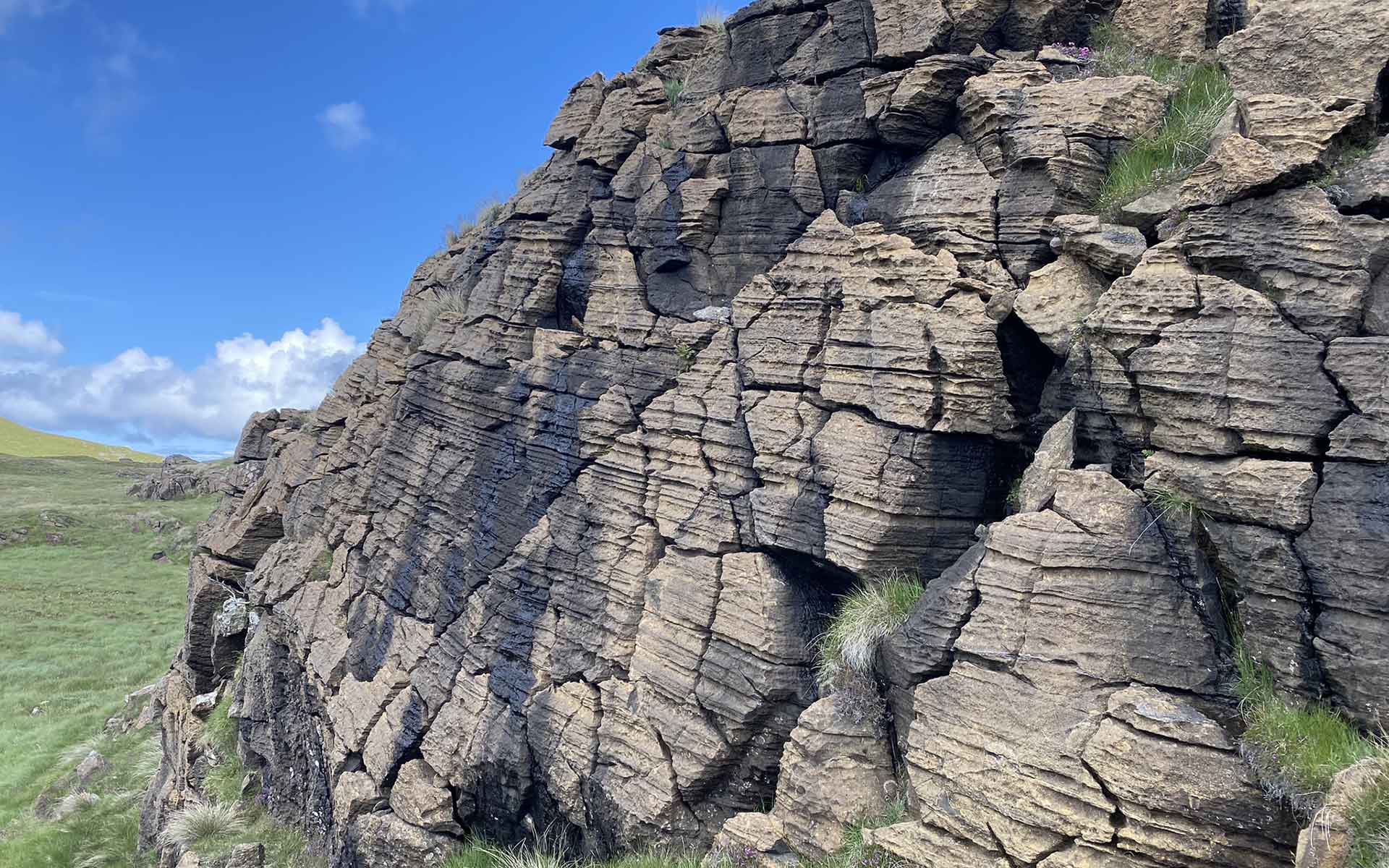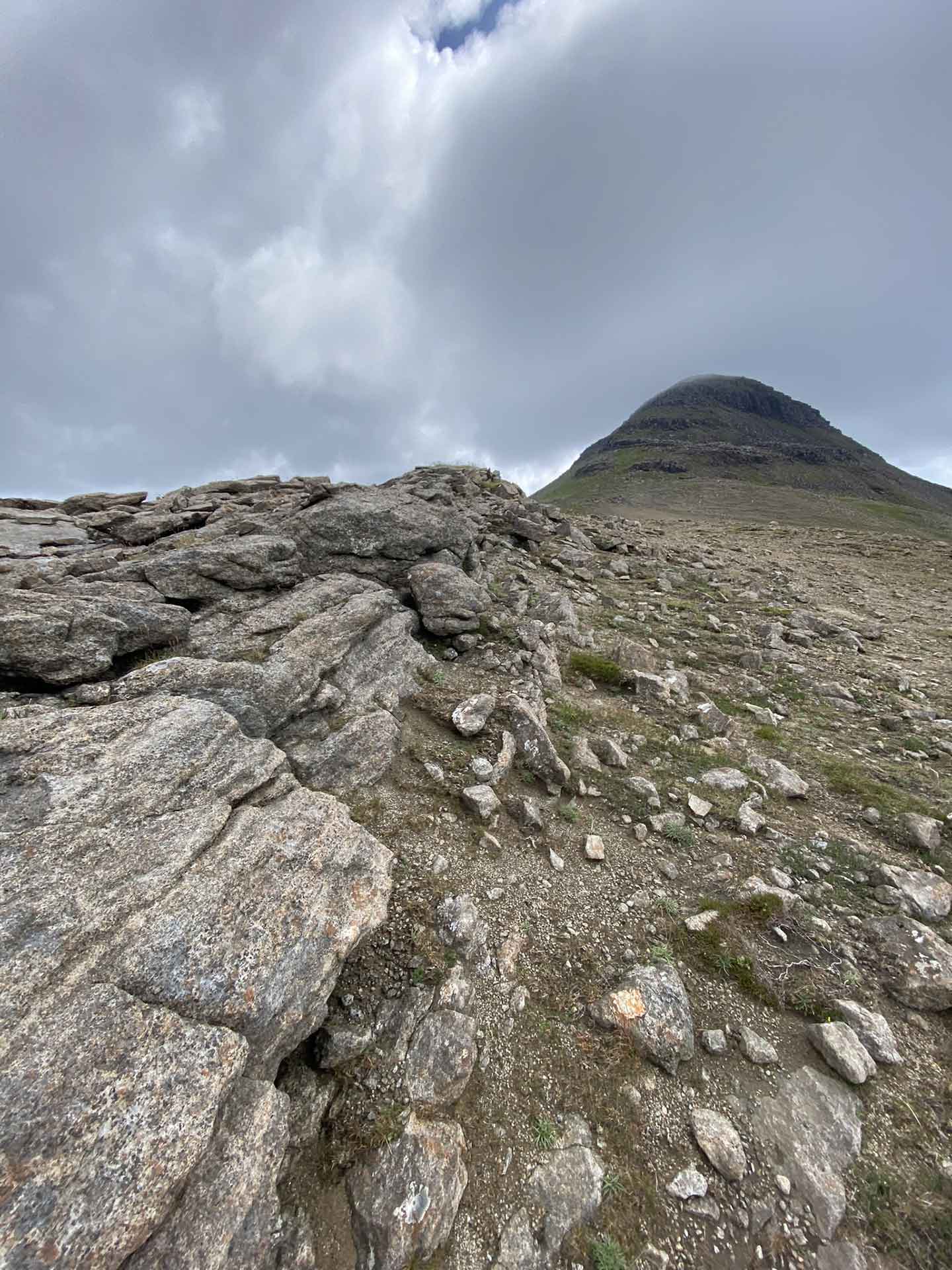
Rhythmically layered feldspathic peridotite close to Long Loch in the Central Intrusion (Brian O’Driscoll).
Geological Period
Eocene
Main geological interest
Igneous and Metamorphic petrology
History of geosciences
Location
NW Scotland, United Kingdom
57°00’00”N, 006°21’00”W
Rhythmically layered feldspathic peridotite close to Long Loch in the Central Intrusion (Brian O’Driscoll).
Superb array of shallowly emplaced ultramafic to felsic igneous rocks that differentiated in an open system and concentrated precious metals.
The Rum Layered Complex is a world class example of open system magma differentiation, featured heavily in classic subject texts (Wager and Brown, 1968). The ELI typifies this and has been returned to for decades to test concepts of magma differentiation by crystal fractionation. Other parts of the intrusion (WLI) contain some of the type examples of in situ crystallisation in plutonic settings – specifically harrisite (considered an equivalent of spinifex texture) formed by relatively deep undercooling of picritic magma. Extreme precious metal (platinum group elements) enrichment in chromitite seams of the ELI have also been used to evaluate models of ore deposit formation.
- Geological description
The Rum Igneous Complex was intruded ~60 million years ago, during rifting and formation of the North Atlantic ocean. The Rum Igneous Complex was intruded into a rifting basin containing Archaean Lewisian gneisses to Mesozoic strata and contemporaneous lavas flows that are all exposed, enabling examination of their relationship with the igneous complex. Sedimentary breccias are possibly associated with proto-caldera forming processes and mafic/ultramafic satellite plugs possibly represent solidified fire fountain roots.
The Rum Igneous Complex is constructed from layered massifs divided into three geographic sectors the: (1) Eastern Layered Intrusion (ELI), built up of 16 macro-rhythmic units that differentiated in batches, composing the majestic Hallival and Askival mountains. Platinum-group element rich Cr-spinel horizons can be found within the ELI; (2) Western Layered Intrusion (WLI), representing the lowest structural level of intrusion, with evidence of picritic magmas and in situ crystallisation to form the spectacular harrisite (up to 2 m long olivine crystals) and (3) Central Layered Intrusion (CLI), which is the feeder zone (Long Loch Fault) of the layered intrusion, into which unconsolidated cumulate slumped and deformed during final stages of solidification. Within the complex are a spectacular array of deformation features, rock types and complex textures.
- Scientific research and tradition
Early work was done by Harker in the early 1900s. Eminent geologists Bailey, Richey and Geikie all visited after the war. Malcolm Brown wrote classic 1956 paper and Rum featured heavily in the classic Wager and Brown 1968 text. Proliferation of work followed sale of island in 1950s – before this, it had been the ‘forbidden isle’.
- Reference
Emeleus, C.H. and Troll, V.R. (2014) ‘The Rum Igneous Centre, Scotland’, Mineralogical Magazine, 78(4), pp. 805–839. Available at: https://doi.org/10.1180/minmag.2014.078.4.04.
Geikie, A. (1897) The ancient volcanoes of Great Britain (2 vol). London, Macmillan. Available at: http://archive.org/details/ancientvolcanoe02geikgoog.
Goodenough, K. et al. (2008) The Geological Society of London – Golden Rum! Available at: https://www.geolsoc.org.uk/Geoscientist/Archive/March-2008/Golden-Rum.
Judd, J.W. (1874) ‘The Secondary Rocks of Scotland. Second Paper. On the Ancient Volcanoes of the Highlands and the Relations of their Products to the Mesozoic Strata’, Quarterly Journal of the Geological Society of London, 30(1–4), pp. 220–302. Available at: https://doi.org/10.1144/GSL.JGS.1874.030.01-04.37.
Upton, B.G.J. et al. (2023) ‘The Central Series of the Rum Igneous Complex, NW Scotland: the rises and falls of magma in a large mafic-ultramafic volcano’, Geology Today, 39(4), pp. 130–143. Available at: https://doi.org/10.1111/gto.12441.
Wager, L.R. and Brown, G.M. (1968) Layered Igneous Rocks. Oliver and Boyd, Edinburgh and London. Available at: https://www.semanticscholar.org/paper/Layered-Igneous-Rocks-Wager-Brown/9e0ef3a52eead4278a836cd12641c1adea6b2f0e.
- Author(s)
James Day.
Scripps Institution of Oceanography, University of California San Diego, USA.
Michele Lustrino.
Sapienza Università di Roma, Italy.
Sebastian Tappe.
Arctic University of Norway.
Roger Mitchell.
Lakehead University, Thunder Bay, Ontario, Canada.
Georg Zellmer.
Massey University, Palmerston North, New Zealand.
Andrew Kerr.
Department of Earth Sciences, Memorial University, St. John’s NL Canada.
Monica Heilbron.
Universidade do Estado do Rio de Janeiro, Brazil.
James Natland.
University of Miami, USA.
Alexei Ivanov.
Institute of the Earth’s Crust, Siberian Branch of the Russian Academy of Sciences, Irkutsk, Russia.
Rajesh Kumar Srivastava.
Baranas Hindu University, Varanasi, India.
Barbara Scott Smith.
Scott-Smith Petrology Inc., Vancouver, Canada.
Mitsuhiro Nakagawa.
Hokkaido University, Japan.
Zhengfu Guo.
Chinese Academy of Science, Beijing, China.
Anna Doroshkevich.
Sobolev Institute of Geology and Mineralogy, Siberian Branch of the Russian Academy of Sciences Novosibirsk, Russia.
Marjorie Wilson.
Leeds University, UK.
Bernard Bonin.
Université Paris-Sud, Orsay Cedex, France.
Julian Pearce.
Cardiff University, UK.


